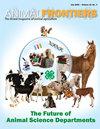Developing precision livestock farming tools for precision dairy farming
IF 3.2
2区 农林科学
Q1 AGRICULTURE, DAIRY & ANIMAL SCIENCE
引用次数: 29
Abstract
For centuries, milk and dairy products have been an important source of dietary energy, protein, and fat for the global population. Currently, milk is the EU’s number one agricultural product, accounting for circa 15% of agricultural output in terms of value (European Parliament, 2015). The EU diary sector is supported by 650,000 specialized dairy farmers and 18 million milking cows and has a labor force of about 1.2 million people (European Parliament, 2015). However, since the abolishment of milk quotas in 2015, farmers are facing increased pressures to exploit the economies of scale by increasing the size of their herds. With larger numbers of cows per farm, farmers no longer have the same time traditionally had to care for their animals. Therefore, the application of technology is becoming more important for EU dairy farmers than ever before. Precision livestock farming (PLF) represents the application of modern information and computer technology (ICT) for the real-time monitoring and management of animals. In dairy production, PLF systems can be important tools to complement and support the skills of the farmer in the monitoring and assessing cow health and welfare. Automated PLF systems enable dairy farmers to manage larger herds on a more time-efficient manner (Rutten et al., 2013). Automated systems exist to monitor behavioral activities for detection of lameness (Kashiha et al., 2013) and eustrus (Dolecheck et al., 2015). However, there are far fewer studies on the design/implementation of cow behavior monitoring for other important health events such as metabolic diseases or mastitis. When developing PLF systems for real-time monitoring of dairy cow health, welfare, and productivity, the development process should be done within a framework specifically designed for living organisms. A core principle in this regard is that any living organism can be considered a CITD system, which stands for complex, individually different, time-varying, and dynamic (Berckmans and Aerts, 2006; Quanten et al., 2006). A living organism is much more complex than any mechanical, electronic or ICT system. The complexity of information transmission in a single cell of a living organism is for example much higher than in most man-made systems (e.g., today’s most powerful microchip). It is obvious that all living organisms are individually different. The general approach in biological research and the management of biological process (e.g., medical world, livestock world) in industry and society is still to compare groups of living organisms by looking for statistical differences between group averages using experiments. However, there is not a single living organism that lives or acts as the purely theoretical average of a group since all living organisms are individually differDeveloping precision livestock farming tools for precision dairy farming为奶牛精准养殖开发精准畜禽养殖工具
几个世纪以来,牛奶和乳制品一直是全球人口膳食能量、蛋白质和脂肪的重要来源。目前,牛奶是欧盟的头号农产品,约占农业产值的15%(欧洲议会,2015年)。欧盟乳制品行业由65万专业奶农和1800万头奶牛支撑,劳动力约为120万人(欧洲议会,2015年)。然而,自2015年取消牛奶配额以来,农民面临越来越大的压力,需要通过扩大牛群规模来利用规模经济。随着每个农场奶牛数量的增加,农民不再有传统上照顾他们的动物的时间。因此,技术的应用对欧盟奶农来说比以往任何时候都更加重要。精准畜牧业(PLF)代表了现代信息和计算机技术(ICT)对动物实时监测和管理的应用。在乳制品生产中,PLF系统可以成为补充和支持农民监测和评估奶牛健康和福利技能的重要工具。自动化PLF系统使奶农能够以更省时的方式管理更大的牛群(Rutten et al., 2013)。现有自动化系统用于监测行为活动,以检测跛行(Kashiha等人,2013年)和发情(Dolecheck等人,2015年)。然而,对其他重要健康事件(如代谢性疾病或乳腺炎)的奶牛行为监测设计/实施的研究要少得多。在开发用于实时监测奶牛健康、福利和生产力的PLF系统时,开发过程应在专门为生物设计的框架内完成。这方面的一个核心原则是,任何活的有机体都可以被认为是一个CITD系统,它代表复杂的、个体不同的、时变的和动态的(Berckmans和Aerts, 2006;Quanten et al., 2006)。一个生命体比任何机械、电子或信息通信技术系统都要复杂得多。例如,在生物体的单个细胞中,信息传输的复杂性远远高于大多数人造系统(例如,当今最强大的微芯片)。很明显,所有的生物个体都是不同的。在工业和社会中,生物研究和生物过程管理(例如,医学界,畜牧业)的一般方法仍然是通过使用实验寻找组平均值之间的统计差异来比较生物体组。然而,没有一个单一的生物体生活或作为一个群体的纯理论平均值,因为所有的生物体都是不同的,开发精确的牲畜养殖工具,用于精确的奶牛养殖
本文章由计算机程序翻译,如有差异,请以英文原文为准。
求助全文
约1分钟内获得全文
求助全文
来源期刊

Animal Frontiers
Veterinary-Food Animals
CiteScore
6.50
自引率
5.60%
发文量
74
期刊介绍:
Animal Frontiers is the official journal of the following globally active professional animal science societies:
ASAS, the American Society of Animal Science
CSAS, the Canadian Society of Animal Science
EAAP, the European Federation of Animal Science
AMSA, the American Meat Science Association
These organizations are dedicated to the advancement and dissemination of science-based knowledge concerning animal agriculture. Animal Frontiers provides a novel forum for innovative and timely perspectives that have relevance to understanding the complex dynamics at work through animal agriculture. Animal Frontiers publishes discussion and position papers that present several international perspectives on the status of high-impact, global issues in animal agriculture. Every issue will explore a theme of broad and current interest within animal science and animal agriculture.
 求助内容:
求助内容: 应助结果提醒方式:
应助结果提醒方式:


